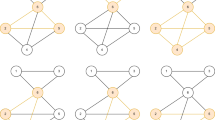Abstract
Clique inequalities appear in linear descriptions of many combinatorial optimisation problems. In general, they form an exponential family and, in addition, the associated separation problem is strongly NP-hard, being equivalent to a maximum weight clique problem. Therefore, most of the known (both exact and heuristic) separation procedures follow the decomposition scheme of a maximum clique algorithm. We introduce a new heuristic, aimed at constructing a collection of (violated) clique inequalities covering all the edges of the underlying graph. We present an extensive computational experience showing that this closely approximates the results of an exact separation oracle while being faster than standard heuristics.



Similar content being viewed by others
References
Atamtürk A, Nemhauser GL, Savelsbergh MWP (2000) Conflict graphs in solving integer programming problems. Eur J Oper Res 121(1):40–55
Avella P, Boccia M, Mannino C, Vasilyev I (2017) Time-indexed formulations for the runway scheduling problem. Transp Sci 51(4):1196–1209
Balas E, Padberg MW (1976) Set partitioning: a survey. Management sciences research report, Graduate School of Industrial Administration, Carnegie-Mellon University
Borndörfer R (1998) Aspects of set packing, partitioning, and covering. Ph. D. thesis, TU Berlin
Borndörfer R, Kormos Z (1997) An algorithm for maximum cliques. Unpublished working paper, Konrad-Zuse-Zentrum für Informationstechnik
Borndörfer R, Weismantel R (2000) Set packing relaxations of some inte]ger programs. Math Program 88(3):425–450
Caprara A, Salazar González JJ (1999) Separating lifted odd-hole inequalities to solve the index selection problem. Discret Appl Math 92(2):111–134
Carraghan R, Pardalos PM (1990) An exact algorithm for the maximum clique problem. Oper Res Lett 9(6):375–382
Corrêa RC, Delle Donne D, Koch I, Marenco J (2017) General cut-generating procedures for the stable set polytope. Discret Appl Math 245:28–41
de Givry S, Katsirelos G (2017) Clique cuts in weighted constraint satisfaction. In: Beck JC (ed) Principles and practice of constraint programming. Springer International Publishing, Cham, pp 97–113
Escudero LF, Landete M, Marín A (2009) A branch-and-cut algorithm for the winner determination problem. Decis Support Syst 46(3):649–659
Groiez M, Desaulniers G, Marcotte O (2014) Valid inequalities and separation algorithms for the set partitioning problem. INFOR: Inf Syst Oper Res 52(4):185–196
Grötschel M, Lovász L, Schrijver A (1988) Geometric algorithms and combinatorial optimization. Springer, Berlin
Grötschel M, Lovász L, Schrijver A (1981) The ellipsoid method and its consequences in combinatorial optimization. Combinatorica 1(2):169–197
Håstad J (1999) Clique is hard to approximate within \(n^{(1-\epsilon )}\). Acta Math 182(1):105–142
Hoffman K, Padberg M (1993) Solving airline crew scheduling problems by branch-and-cut. Manag Sci 39(6):657–682
Intel distribution for Python (2018) https://software.intel.com/en-us/distribution-for-python
Johnson DJ, Trick MA (eds) (1996) Cliques, coloring, and satisfiability: second DIMACS implementation challenge, Workshop, October 11–13, 1993. American Mathematical Society, Boston, MA
Letchford AN, Rossi F, Smriglio S (2018) The stable set problem: clique and nodal inequalities revisited. Optimization Online, http://www.optimization-online.org/DB_HTML/2018/05/6612.html
Nemhauser GL, Sigismondi G (1992) A strong cutting plane/branch-and-bound algorithm for node packing. J Oper Res Soc 43(5):443–457
Niskanen S, Östergård PRJ (2002) Routines for clique searching. http://users.aalto.fi/~pat/cliquer.html
Padberg MW (1973) On the facial structure of set packing polyhedra. Math Program 5(1):199–215
Pardalos P, Rappe J, Resende MGC (1998) An exact parallel algorithm for the maximum clique problem. In: De Leone R et al (eds) High performance algorithms and software in nonlinear optimization. Springer, Boston, pp 279–300
Rossi F, Smriglio S (2001) A set packing model for the ground holding problem in congested networks. Eur J Oper Res 131(2):400–416
Spoorendonk S, Desaulniers G (2010) Clique inequalities applied to the vehicle routing problem with time windows. INFOR J 48(1):53–67
SCIP Optimization Suite (2018). http://scip.zib.de/
Waterer H, Johnson EL, Nobili P, Savelsbergh MWP (2002) The relation of time indexed formulations of single machine scheduling problems to the node packing problem. Math Program 93(3):477–494
Acknowledgements
This study was funded by Italian Ministry of Education and Research, National Research Program PRIN 2015, Grant No. 20153TXRX9.
Author information
Authors and Affiliations
Corresponding author
Ethics declarations
Conflict of interest
All authors declare that they have no conflict of interest
Ethical approval
This article does not contain any studies with human participants or animals performed by any of the authors.
Additional information
Communicated by P. Beraldi, M. Boccia, C. Sterle.
Publisher's Note
Springer Nature remains neutral with regard to jurisdictional claims in published maps and institutional affiliations.
Rights and permissions
About this article
Cite this article
Marzi, F., Rossi, F. & Smriglio, S. Computational study of separation algorithms for clique inequalities. Soft Comput 23, 3013–3027 (2019). https://doi.org/10.1007/s00500-019-03769-y
Published:
Issue Date:
DOI: https://doi.org/10.1007/s00500-019-03769-y




